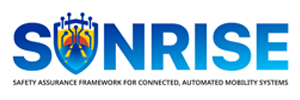Cooperative, Connected and Automated Mobility (CCAM) is rapidly developing and is bound to revolutionise the transportation sector as it aims to reduce accidents, congestion, and emissions. However, as with any new technology, there are risks associated with the deployment of CCAM systems. One of the most significant challenges is ensuring the safety of passengers, pedestrians, and other road users.
The SUNRISE project addresses CCAM safety assurance by creating a connection between the various “silos” into which safety assurance testing methodologies and tools have so far tended to be segregated. Such an approach also aims to overcome the lack of safety testing data interoperability, which prevents different entities from establishing harmonised validation methods and tools.
Vision and collaboration with similar projects
To achieve its goals to harmonise safety-assurance testing and establish a foundation for a federated European scenario database, the SUNRISE project aims to connect and network stakeholders that have specific interest in CCAM safety assurance. The project has established contact with similar projects worldwide and is working actively to promote its objectives through cooperation.
In Europe, several research and innovation projects funded by the European Union are addressing the issues of stakeholder validation and testing in CCAM. For instance, the FAME project, which focuses on developing and validating common methodologies to enable comparability and complementarity of all the testing and large-scale demonstration of CCAM in Europe, is closely connected. SUNRISE was present at the EUCAD 2023 event – which is organised by the European Commission, with the support of FAME in collaboration with the CCAM Partnership. Project coordinator, Stefan de Vries, spoke during a breakout session on “New software and hardware for CCAM, and their validation”, in which he presented the project features and its working plan.
International cooperation and stakeholder engagement
SUNRISE is actively cooperating with national and EU projects but its horizon expands beyond Europe. At the ITS European Congress in Lisbon, SUNRISE held a joint workshop entitled “Strategic Liaison Roadmap 2023” with two related projects, the German project VVMethods and the Japanese SAKURA.
Collaboration and international cooperation are critical for the success of CCAM’s safety assurance. Standardised and harmonised approaches will ensure a faster and safer deployment of Automated Mobility in different parts of the world. Cooperation between international safety bodies, industry associations and similar initiatives worldwide are essential in paving the way for large-scale deployment of safe CCAM.
To facilitate the discussion between all the parties concerned, SUNRISE is inviting experts in the field to join its Expert Platform, a virtual space that has been specifically designed to make interaction and knowledge sharing among stakeholders seamless. A Cooperation Platform has also been built and integrated in the SUNRISE project’s website, with the aim of connecting experts to enhance the discussion on CCAM safety assurance by collecting experienced views on the topic.
SUNRISE towards Vision Zero
The SUNRISE project responds to the R&I needs of Cluster 3 (Validation) of the CCAM Partnership. However, the project’s harmonisation and collaboration activities are also relevant for Cluster 7 (Coordination). This perfectly exemplifies the interlinking of the seven CCAM-Partnership Clusters and the importance of input flowing from one to the other.
SUNRISE partners will assess already existing scenario databases and harmonise them, with the ultimate goal of making the adoption and use of the developed framework a reality. The objective is to create a flexible and scalable framework that can adapt to current and future technologies. Shared effort and understanding of standardisation processes become vital in ensuring global alignment and enabling effective communication on CCAM safety technology. This integrated initiative can also create new business opportunities and accelerate the journey towards Vision-zero and enhanced road safety.


